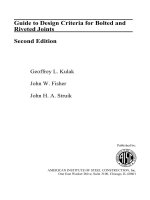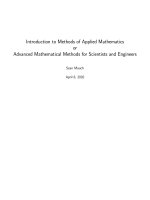Guide to RISC processors for programmers and engineers
Bạn đang xem bản rút gọn của tài liệu. Xem và tải ngay bản đầy đủ của tài liệu tại đây (1.31 MB, 387 trang )
Guide to RISC Processors
Sivarama P. Dandamudi
Guide to RISC Processors
for Programmers and Engineers
Sivarama P. Dandamudi
School of Computer Science
Carleton University
Ottawa, ON K1S 5B6
Canada
Library of Congress Cataloging-in-Publication Data
Dandamudi, Sivarama P., 1955–
Guide to RISC processors / Sivarama P. Dandamudi.
p. cm.
Includes bibliographical references and index.
ISBN 0-387-21017-2 (alk. paper)
1. Reduced instruction set computers. 2. Computer architecture. 3. Assembler language
(Computer program language) 4. Microprocessors—Programming. I. Title.
QA76.5.D2515 2004
004.3—dc22 2004051373
ISBN 0-387-21017-2 Printed on acid-free paper.
© 2005 Springer Science+Business Media, Inc.
All rights reserved. This work may not be translated or copied in whole or in part without the written permission
of the publisher (Springer Science+Business Media, Inc., 233 Spring Street, New York, NY 10013, USA),
except for brief excerpts in connection with reviews or scholarly analysis. Use in connection with any form of
information storage and retrieval, electronic adaptation, computer software, or by similar or dissimilar method-
ology now known or hereafter developed is forbidden.
The use in this publication of trade names, trademarks, service marks, and similar terms, even if they are not
identified as such, is not to be taken as an expression of opinion as to whether or not they are subject to
proprietary rights.
Printed in the United States of America. (HAM)
987654321 SPIN 10984949
springeronline.com
To
my parents, Subba Rao and Prameela Rani,
my wife, Sobha,
and
my daughter, Veda
Preface
Popular processor designs can be broadly divided into two categories: Complex Instruc-
tion Set Computers (CISC) and Reduced Instruction Set Computers (RISC). The dominant
processor in the PC market, Pentium, belongs to the CISC category. However, the recent
trend is to use the RISC designs. Even Intel has moved from CISC to RISC design for
their 64-bit processor. The main objective of this book is to provide a guide to the archi-
tecture and assembly language of the popular RISC processors. In all, we cover five RISC
designs in a comprehensive manner.
To explore RISC assembly language, we selected the MIPS processor, which is ped-
agogically appealing as it closely adheres to the RISC principles. Furthermore, the avail-
ability of the SPIM simulator allows us to use a PC to learn the MIPS assembly language.
Intended Use
This book is intended for computer professionals and university students. Anyone who is
interested in learning about RISC processors will benefit from this book, which has been
structured so that it can be used for self-study. The reader is assumed to have had some
experience in a structured, high-level language such as C. However, the book does not
assume extensive knowledge of any high-level language—only the basics are needed.
Assembly language programming is part of several undergraduate curricula in com-
puter science, computer engineering, and electrical engineering departments. This book
can be used as a companion text in those courses that teach assembly language.
vii
viii Preface
Features
Here is a summary of the special features that set this book apart.
• This probably is the only book on the market to cover five popular RISC architec-
tures: MIPS, SPARC, PowerPC, Itanium, and ARM.
• There is a methodical organization of chapters for a step-by-step introduction to the
MIPS assembly language.
• This book does not use fragments of code in examples. All examples are complete
in the sense that they can be assembled and run giving a better feeling as to how
these programs work.
• Source code for the MIPS assembly language program examples is available from
the book’s Web site (www.scs.carleton.ca/˜sivarama/risc_book).
• The book is self-contained and does not assume a background in computer organi-
zation. All necessary background material is presented in the book.
• Interchapter dependencies are kept to a minimum to offer maximum flexibility to
instructors in organizing the material. Each chapter provides an overview at the
beginning and a summary at the end.
• An extensive set of programming exercises is provided to reinforce the MIPS as-
sembly language concepts discussed in Part III of the book.
Overview and Organization
We divide the book into four parts. Part I presents introductory topics and consists of the
first three chapters. Chapter 1 provides an introduction to CISC and RISC architectures. In
addition, it introduces assembly language and gives reasons for programming in assembly
language. The next chapter discusses processor design issues including the number of
addresses used in processor instructions, how flow control is altered by branches and
procedure calls, and other instruction set design issues. Chapter 3 presents the RISC
design principles.
The second part describes several RISC architectures. In all, we cover five architec-
tures: MIPS, PowerPC, SPARC, Itanium, and ARM. For each architecture, we provide
many details on its instruction set. Our discussion of MIPS in this part is rather brief
because we devote the entire Part III to its assembly language.
The third part, which consists of nine chapters, covers the MIPS assembly language.
This part allows you to get hands-on experience in writing the MIPS assembly language
programs. You don’t need a MIPS-based system to do this! You can run these programs
on your PC using the SPIM simulator. Our thanks go to Professor James Larus for writing
the simulator, for which we provide details on installation and use.
The last part consists of several appendices. These appendices give reference informa-
tion on various number systems, character representation, and the MIPS instruction set.
In addition, we also give several programming exercises so that you can practice writing
MIPS assembly language programs.
Preface ix
Acknowledgments
Several people have contributed, either directly or indirectly, to the writing of this book.
First and foremost, I would like to thank Sobha and Veda for their understanding and
patience!
I want to thank Ann Kostant, Executive Editor and Wayne Wheeler, Associate Editor,
both at Springer, for their enthusiastic support for the project. I would also like to express
my appreciation to the staff at the Springer production department for converting my
camera-ready copy into the book in front of you.
I also express my appreciation to the School of Computer Science, Carleton University
for providing a great atmosphere to complete this book.
Feedback
Works of this nature are never error-free, despite the best efforts of the authors, editors, and
others involved in the project. I welcome your comments, suggestions, and corrections by
electronic mail.
Carleton University Sivarama Dandamudi
Ottawa, Canada
April 2004 />Contents
Preface vii
PART I: Overview 1
1 Introduction 3
Processor Architecture . 3
RISCVersusCISC 5
What Is Assembly Language? . . 7
Advantages of High-Level Languages 9
Why Program in Assembly Language? 10
Summary 11
2 Processor Design Issues 13
Introduction . 13
Number of Addresses . . 14
TheLoad/StoreArchitecture 20
Processor Registers . . . 22
FlowofControl 22
ProcedureCalls 26
HandlingBranches 28
InstructionSetDesignIssues 32
Summary 36
3 RISC Principles 39
Introduction . 39
Evolution of CISC Processors . . 40
WhyRISC? 41
RISCDesignPrinciples 43
Summary 44
xi
xii Contents
PART II: Architectures 45
4 MIPS Architecture 47
Introduction . 47
Registers 48
RegisterUsageConvention 48
Addressing Modes . . . 50
InstructionFormat 51
MemoryUsage 52
Summary 53
5 SPARC Architecture 55
Introduction . 55
Registers 56
Addressing Modes . . . 58
InstructionFormat 59
InstructionSet 59
Procedures and Parameter Passing 69
Summary 76
6 PowerPC Architecture 79
Introduction . 79
RegisterSet 81
Addressing Modes . . . 83
InstructionFormat 84
InstructionSet 86
Summary 96
7 Itanium Architecture 97
Introduction . 97
Registers 98
Addressing Modes . . . 100
ProcedureCalls 101
InstructionFormat 102
Instruction-LevelParallelism 105
InstructionSet 106
HandlingBranches 112
SpeculativeExecution 114
BranchPredictionHints 119
Summary 119
Contents xiii
8 ARM Architecture 121
Introduction . 121
Registers 123
Addressing Modes . . . 125
InstructionFormat 128
InstructionSet 131
Summary 145
PART III: MIPS Assembly Language 147
9 SPIM Simulator and Debugger 149
Introduction . 149
SimulatorSettings 152
Running a Program . . . 153
Debugging . 154
Summary 157
10 Assembly Language Overview 159
Introduction . 159
Assembly Language Statements . 160
SPIMSystemCalls 161
SPIM Assembler Directives 162
MIPSProgramTemplate 165
DataMovementInstructions 165
LoadInstructions 166
StoreInstructions 167
Addressing Modes . . . 167
SampleInstructions 168
OurFirstProgram 172
Illustrative Examples . . 174
Summary 182
11 Procedures and the Stack 183
Introduction . 183
ProcedureInvocation 186
ReturningfromaProcedure 188
Parameter Passing . . . 189
OurFirstProgram 189
StackImplementationinMIPS 192
Parameter Passing via the Stack . . 196
Illustrative Examples . . 200
Passing Variable Number of Parameters . . . 207
Summary 210
xiv Contents
12 Addressing Modes 211
Introduction . 211
Addressing Modes . . . 212
Processing Arrays 214
OurFirstProgram 217
Illustrative Examples . . 219
Summary 224
13 Arithmetic Instructions 225
Introduction . 225
Addition . . . 226
Subtraction 226
Multiplication 228
Division 229
OurFirstProgram 230
Illustrative Examples . . 232
Summary 242
14 Conditional Execution 243
Introduction . 243
ComparisonInstructions 244
UnconditionalBranchInstructions 246
ConditionalBranchInstructions 248
OurFirstProgram 249
Illustrative Examples . . 252
IndirectJumps 259
IndirectProcedures 262
Summary 267
15 Logical and Shift Operations 269
Introduction . 269
LogicalInstructions 270
ShiftInstructions 276
RotateInstructions 280
OurFirstProgram 281
Illustrative Examples . . 284
Summary 290
16 Recursion 291
Introduction . 291
OurFirstProgram 292
Illustrative Examples . . 295
Contents xv
RecursionVersusIteration 303
Summary 304
17 Floating-Point Operations 305
Introduction . 305
FPURegisters 306
Floating-PointInstructions 307
OurFirstProgram 312
Illustrative Examples . . 314
Summary 322
Appendices 323
A Number Systems 325
PositionalNumberSystems 325
ConversiontoDecimal 327
ConversionfromDecimal 328
Binary/Octal/HexadecimalConversion 329
UnsignedIntegers 330
SignedIntegers 331
Floating-Point Representation . . 334
Summary 336
B Character Representation 339
Character Representation 339
ASCIICharacterSet 340
C MIPS Instruction Set Summary 343
D Programming Exercises 365
Bibliography 375
Index 379
PART I
Overview
1
Introduction
We start this chapter with an overview of what this book is about. As programmers we
usually write our programs in a high-level language such as Java. However, such lan-
guages shield us from the system’s internal details. Because we want to explore the RISC
architectures, it is best done by knowing the processor’s language. That’s why we look at
the assembly language in the later chapters of the book.
Processor Architecture
Computers are complex systems. How do we manage complexity of these systems? We
can get clues by looking at how we manage complex systems in life. Think of how a large
corporation is managed. We use a hierarchical structure to simplify the management:
president at the top and workers at the bottom. Each level of management filters out
unnecessary details on the lower levels and presents only an abstracted version to the
higher-level management. This is what we refer to as abstraction. We study computer
systems by using layers of abstraction.
Different people view computer systems differently depending on the type of their
interaction. We use the concept of abstraction to look at only the details that are neces-
sary from a particular viewpoint. For example, a computer user interacts with the system
through an application program. For the user, the application is the computer! Suppose
you are interested in browsing the Internet. Your obvious choice is to interact with the sys-
tem through a Web browser such as the Netscape™ Communicator or Internet Explorer.
On the other hand, if you are a computer architect, you are interested in the internal de-
tails that do not interest a normal user of the system. One can look at computer systems
from several different perspectives. Our interest in this book is in looking at processor
architectural details.
A programmer’s view of a computer system depends on the type and level of language
she intends to use. From the programmer’s viewpoint, there exists a hierarchy from low-
level languages to high-level languages (see Figure 1.1). As we move up in this hierarchy,
3
4 Guide to RISC Pr ocessor s
Hardware
Microprogram control
Machine language
High-level languages
Application programs
Assembly language
Machine-specific
Machine-independent High-level languages
Low-level languages
Figure 1.1 A programmer’s view of a computer system.
the level of abstraction increases. At the lowest level, we have the machine language that
is the native language of the machine. This is the language understood by the machine
hardware. Because digital computers use 0 and 1 as their alphabet, machine language
naturally uses 1s and 0s to encode the instructions. One level up, there is the assembly
language as shown in Figure 1.1. Assembly languag e does not use 1s and 0s; instead, it
uses mnemonics to express the instructions. Assembly language is closely related to the
machine language.
As programmers, we use the instruction set architecture (ISA) as a useful abstraction
to understand the processor’s internal details. What is an ISA? It essentially describes the
processor at a logical level, as opposed to giving the implementation details. This abstrac-
tion suits us very well as we are interested in the logical details of the RISC processor
without getting bogged down by the myriad implementation details.
The ISA defines the personality of a processor and indirectly influences the overall
system design. The ISA specifies how a processor functions: what instructions it executes
and what interpretation is given to these instructions. This, in a sense, defines a logical
processor. If these specifications are precise, they give freedom to various chip manu-
facturers to implement physical designs that look functionally the same at the ISA level.
Thus, if we run the same program on these implementations, we get the same results. Dif-
ferent implementations, however, may differ in performance and price. For example, the
Intel 32-bit ISA (IA-32) has several implementations including the Pentium processors,
cheaper Celeron processors, high-performance Xeon processors, and so on.
Chapter 1 • Introduction 5
Two popular examples of ISA specifications are the SPARC and JVM. The rationale
behind having a precise ISA-level specification for the SPARC is to let multiple vendors
design their own processors that look the same at the ISA level. The JVM, on the other
hand, takes a different approach. Its ISA-level specification can be used to create a soft-
ware layer so that the processor looks like a Java processor. Thus, in this case, we do not
use a set of hardware chips to implement the specifications, but rather use a software layer
to simulate the virtual processor. Note, however, that there is nothing stopping us from
implementing these specifications in hardware (even though this is not usually the case).
Why create the ISA layer? The ISA-level abstraction provides details about the ma-
chine that are needed by the programmers. The idea is to have a common platform to
execute programs. If a program is written in C, a compiler translates it into the equivalent
machine language program that can run on the ISA-level logical processor. Similarly, if
you write your program in FORTRAN, use a FORTRAN compiler to generate code that
can execute on the ISA-level logical processor. At the ISA level, we can divide the designs
into two categories: RISC and CISC. We discuss these two categories in the next section.
RISC Versus CISC
There are two basic types of processor design philosophies: reduced instruction set com-
puters (RISC) and complex instruction set computers (CISC). The Intel IA-32 architecture
belongs to the CISC category. The architectures we describe in the next part are all exam-
ples of the RISC category.
Before we dig into the details of these two designs, let us talk about the current trend.
In the 1970s and early 1980s, processors predominantly followed the CISC designs. The
current trend is to use the RISC philosophy. To understand this shift from CISC to RISC,
we need to look at the motivation for going the CISC way initially. But first we have to
explain what these two types of design philosophies are.
As the name suggests, CISC systems use complex instructions. What is a complex
instruction? For example, adding two integers is considered a simple instruction. But, an
instruction that copies an element from one array to another and automatically updates
both array subscripts is considered a complex instruction. RISC systems use only simple
instructions. Furthermore, RISC systems assume that the required operands are in the
processor’s internal registers, not in the main memory. We discuss processor registers in
the next chapter. For now, think of them as scratchpads inside the processor.
A CISC design does not impose such restrictions. So what? It turns out that char-
acteristics like simple instructions and restrictions like register-based operands not only
simplify the processor design but also result in a processor that provides improved ap-
plication performance. We give a detailed list of RISC design characteristics and their
advantages in Chapter 3.
How come the early designers did not think about the RISC way of designing proces-
sors? Several factors contributed to the popularity of CISC in the 1970s. In those days,
memory was very expensive and small in capacity. For example, even in the mid-1970s,
6 Guide to RISC Pr ocessor s
(a) CISC implementation (b) RISC implementation
Hardware
Microprogram control
ISA level
Hardware
ISA level
Figure 1.2 The ISA-level architecture can be implemented either directly in hardware or
through a microprogrammed control.
the price of a small 16 KB memory was about $500. You can imagine the cost of memory
in the 1950s and 1960s. So there was a need to minimize the amount of memory required
to store a program. An implication of this requirement is that each processor instruction
must do more, leading to complex instruction set designs. These designs caused another
problem. How could a processor be designed that could execute such complex instruc-
tions using the technology of the day? Complex instructions meant complex hardware,
which was also expensive. This was a problem processor designers grappled with until
Wilkes proposed microprogrammed control in the early 1950s.
A microprogram is a small run-time interpreter that takes the complex instruction and
generates a sequence of simple instructions that can be executed by the hardware. Thus
the hardware need not be complex. Once it became possible to design such complex
processors by using microprogrammed control, designers went crazy and tried to close
the semantic gap between the instructions of the processor and high-level languages. This
semantic gap refers to the fact that each instruction in a high-level language specifies a lot
more work than an instruction in the machine language. Think of a while loop statement
in a high-level language such as C, for example. If we have a processor instruction with
the while loop semantics, we could just use one machine language instruction. This
explains why most CISC designs use microprogrammed control, as shown in Figure 1.2.
RISC designs, on the other hand, eliminate the microprogram layer and use the hard-
ware to directly execute instructions. Here is another reason why RISC processors can
potentially give improved performance. One advantage of using microprogrammed con-
trol is that we can implement variations on the basic ISA architecture by simply modifying
the microprogram; there is no need to change the underlying hardware, as shown in Fig-
ure 1.3. Thus it is possible to come up with cheaper versions as well as high-performance
processors for the same family of processors.
Chapter 1 • Introduction 7
Microprogram 1
ISA 1
Hardware
Microprogram 2
ISA 2
Microprogram 3
ISA 3
Figure 1.3 Variations on the ISA-level architecture can be implemented by changing the
microprogram.
What Is Assembly Language?
Assembly language is directly influenced by the instruction set and architecture of the pro-
cessor. Assembly language programming is referred to as low-level programming because
each assembly language instruction performs a much lower-level task compared to an in-
struction in a high-level language. As a consequence, to perform the same task, assembly
language code tends to be much larger than the equivalent high-level language code. As-
sembly language instructions are native to the processor used in the system. For example,
a program written in the Intel assembly language cannot be executed on the PowerPC
processor. Programming in the assembly language also requires knowledge about internal
system details such as the processor architecture, memory organization, and so on.
Machine language is closely related to the assembly language. Typically, there is
a one-to-one correspondence between the assembly language and machine language in-
structions. The processor understands only the machine language, whose instructions
consist of strings of 1s and 0s. We say more on these two languages later.
Here are some IA-32 assembly language examples:
inc result
mov class_size,45
and mask1,128
add marks,10
The first instruction increments the variable result. This assembly language in-
struction is equivalent to
result++;
in C. The second instruction initializes class_size to 45. The equivalent statement in
Cis
8 Guide to RISC Pr ocessor s
class_size = 45;
The third instruction performs the bitwise and operation on mask1 and can be expressed
in C as
mask1 = mask1 & 128;
The last instruction updates marks by adding 10. In C, this is equivalent to
marks = marks + 10;
As you can see from these examples, most instructions use two addresses. In these in-
structions, one operand doubles as a source and destination (for example, class_size
and marks). In contrast, the MIPS instructions use three addresses as shown below:
andi $t2,$t1,15
addu $t3,$t1,$t2
move $t2,$t1
The operands of these instructions are in processor registers. The processor registers
are identified by $.Theandi instruction performs bitwise and of $t1 register contents
with 15 and writes the result in the $t2 register. The second instruction adds the contents
of $t1 and $t2 and stores the result in $t3.
The last instruction copies the $t1 value into $t2. In contrast to our claim that MIPS
uses three addresses, this instruction seems to use only two addresses. This is not really
an instruction supported by the MIPS processor: it is an assembly language instruction.
When translated by the MIPS assembler, this instruction is replaced by the following
processor instruction.
addu $t2,$0,$t1
The second operand in this instruction is a special register that holds constant zero. Thus,
copying the $t1 value is treated as adding zero to it.
We can appreciate the readability of the assembly language instructions by looking at
the equivalent machine language instructions. Here are some IA-32 and MIPS machine
language examples:
IA-32 Examples
Assembly language Operation Machine language (in hex)
nop No operation 90
inc result Increment FF060A00
mov class_size, 45 Copy C7060C002D00
and mask, 128 Logical and 80260E0080
add marks, 10 Integer addition 83060F000A
Chapter 1 • Introduction 9
MIPS Examples
Assembly language Operation Machine language (in hex)
nop No operation 00000000
move $t2,$t15 Copy 000A2021
andi $t2,$t1,15 Logical and 312A000F
addu $t3,$t1,$t2 Integer addition 012A5821
In the above tables, machine language instructions are written in the hexadecimal
number system. If you are not familiar with this number system, consult Appendix A
for a detailed discussion of various number systems. These examples visibly demonstrate
one of the key differences between CISC and RISC designs: RISC processors use fixed-
length machine language instructions whereas the machine language instructions of CISC
processors vary in length.
It is obvious from this discussion that understanding the code of a program, written
in an assembly language, is difficult. Before looking at why we program in assembly
language, let’s see the main advantages of high-level languages.
Advantages of High-Level Languages
High-level languages are preferred to program applications inasmuch as they provide a
convenient abstraction of the underlying system suitable for problem solving. Here are
some advantages of programming in a high-level language.
1. Program development is faster.
Many high-level languages provide structures (sequential, selection, iterative) that
facilitate program development. Programs written in a high-level language are rela-
tively small compared to the equivalent programs written in an assembly language.
These programs are also easier to code and debug.
2. Programs are easier to maintain.
Programming a new application can take from several weeks to several months and
the lifecycle of such an application software can be several years. Therefore, it is
critical that software development be done with a view towards software maintain-
ability, which involves activities ranging from fixing bugs to generating the next
version of the software. Programs written in a high-level language are easier to un-
derstand and, when good programming practices are followed, easier to maintain.
Assembly language programs tend to be lengthy and take more time to code and
debug. As a result, they are also difficult to maintain.
3. Programs are portable.
High-level language programs contain very few processor-dependent details. As a
result, they can be used with little or no modification on different computer systems.
In contrast, assembly language programs are processor-specific.
10 Guide to RISC Pr ocessor s
Why Program in Assembly Language?
The previous section gives enough reasons to discourage you from programming in as-
sembly language. However, there are two main reasons why programming is still done in
assembly language: efficiency and accessibility to system hardware.
Efficiency refers to how “good” a program is in achieving a given objective. Here we
consider two objectives based on space (space-efficiency) and time (time-efficiency).
Space-efficiency refers to the memory requirements of a program (i.e., the size of the
executable code). Program A is said to be more space-efficient if it takes less memory
space than program B to perform the same task. Very often, programs written in an
assembly language tend to be more compact than those written in a high-level language.
Time-efficiency refers to the time taken to execute a program. Obviously a program
that runs faster is said to be better from the time-efficiency point of view. In general,
assembly language programs tend to run faster than their high-level language versions.
The superiority of assembly language in generating compact code is becoming in-
creasingly less important for several reasons. First, the savings in space pertain only to
the program code and not to its data space. Thus, depending on the application, the sav-
ings in space obtained by converting an application program from some high-level lan-
guage to an assembly language may not be substantial. Second, the cost of memory has
been decreasing and memory capacity has been increasing. Thus, the size of a program
is not a major hurdle anymore. Finally, compilers are becoming “smarter” in generating
code that is both space- and time-efficient. However, there are systems such as embedded
controllers and handheld devices in which space-efficiency is very important.
One of the main reasons for writing programs in assembly language is to generate
code that is time-efficient. The superiority of assembly language programs in producing
efficient code is a direct manifestation of specificity. That is, assembly language pro-
grams contain only the code that is necessary to perform the given task. Even here, a
“smart” compiler can optimize the code that can compete well with its equivalent written
in an assembly language. Although this gap is narrowing with improvements in compiler
technology, assembly language still retains its advantage for now.
The other main reason for writing assembly language programs is to have direct con-
trol over system hardware. High-level languages, on purpose, provide a restricted (ab-
stract) view of the underlying hardware. Because of this, it is almost impossible to per-
form certain tasks that require access to the system hardware. For example, writing a
device driver to a new scanner on the market almost certainly requires programming in
an assembly language. Because assembly language does not impose any restrictions, you
can have direct control over the system hardware. If you are developing system software,
you cannot avoid writing assembly language programs.
There is another reason for our interest in the assembly language. It allows us to look
at the internal details of the processors. For the RISC processors discussed in the next part
of the book, we present their assembly language instructions. In addition, Part III gives
you hands-on experience in MIPS assembly language programming.
Chapter 1 • Introduction 11
Summary
We identified two major processor designs: CISC and RISC. We discussed the differences
between these two design philosophies. The Intel IA-32 architecture follows the CISC de-
sign whereas several recent processor families follow the RISC designs. Some examples
belonging to the RISC category are the MIPS, SPARC, and ARM processor families.
We also introduced assembly language to prepare the ground for Part III of the book.
Specifically, we looked at the advantages and problems associated with assembly language
vis-`a-vis high-level languages.
2
Processor Design Issues
In this chapter we look at some of the basic choices in the processor design space. We
start our discussion with the number of addresses used in processor instructions. This
is an important characteristic that influences instruction set design. We also look at the
load/store architecture used by RISC processors.
Another important aspect that affects performance of the overall system is the flow
control. Flow control deals with issues such as branching and procedure calls. We discuss
the general principles used to efficiently implement branching and procedure invocation
mechanisms. We wrap up the chapter with a discussion of some of the instruction set
design issues.
Introduction
One of the characteristics of the instruction set architecture (ISA) that shapes the archi-
tecture is the number of addresses used in an instruction. Most operations can be divided
into binary or unary operations. Binary operations such as addition and multiplication re-
quire two input operands whereas the unary operations such as the logical not need only
a single operand. Most operations produce a single result. There are exceptions, however.
For example, the division operation produces two outputs: a quotient and a remainder.
Because most operations are binary, we need a total of three addresses: two addresses
to specify the two input operands and one to specify where the result should go. Typi-
cal operations require two operands, therefore we need three addresses: two addresses to
specify the two input operands and the third one to indicate where the result should be
stored.
Most processors specify three addresses. We can reduce the number of addresses to
two by using one address to specify a source address as well as the destination address.
The Intel IA-32 processors use the two-address format. It is also possible to have in-
structions that use only one or even zero address. The one-address machines are called
13
14 Guide to RISC Pr ocessor s
Table 2.1 Sample three-address machine instructions
Instruction Semantics
add dest,src1,src2 Adds the two values at src1 and src2 and
stores the result in dest
sub dest,src1,src2
Subtracts the second source operand at
src2 from the first at src1 (src1 −
src2) and stores the result in dest
mult dest,src1,src2
Multiplies the two values at src1 and
src2 and stores the result in dest
accumulator machines and the zero-address machines are called stack machines. We dis-
cuss the pros and cons of these schemes later.
RISC processors tend to use a special architecture known as the load/store architec-
ture. In this architecture, special load and store instructions are used to move data between
the processor’s internal registers and memory. All other instructions expect the necessary
operands to be present in the processor internal registers. Vector processors originally
used the load/store architecture. We present more details on the load/store architecture
later.
Instruction set design involves several other issues. The addressing mode is another
important aspect that specifies where the operands are located. CISC designs typically
allow a variety of addressing modes, whereas only a couple of addressing modes are
supported by RISC. The addressing modes and number of addresses directly influence
the instruction format. These and other issues such as instruction and operand types are
discussed in the remainder of the chapter.
Number of Addresses
Most recent processors use three addresses. However, it is possible to design systems with
two, one, or even zero addresses. In the rest of this section, we give a brief description of
these four types of machines. After presenting these details, we discuss their advantages
and disadvantages.
Three-Address Machines
In three-address machines, instructions carry all three addresses explicitly. The RISC
processors we discuss in later chapters use three addresses. Table 2.1 gives some sample
instructions of a three-address machine.









